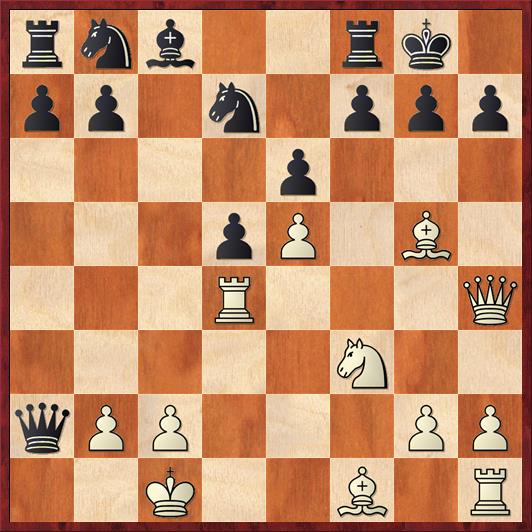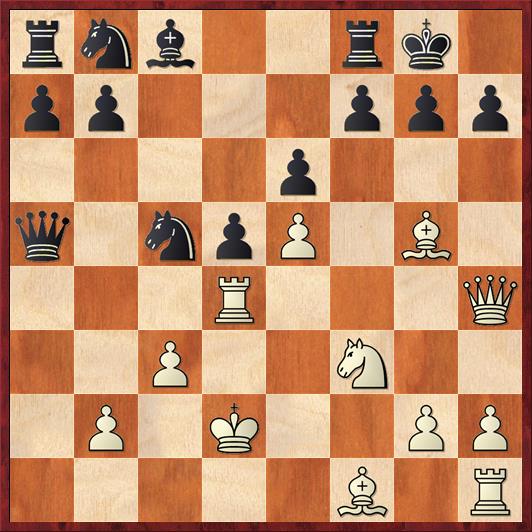After six rounds of the Tuesday Night Marathon at the Mechanics Institute in San Francisco, I realized something kind of odd. I hadn’t played a single sacrifice in any of my first five games (in one round I took a half-point bye, so obviously no sacrifices in that game). Well, of course sacrifices aren’t always appropriate, but I still took this as a sign that I was perhaps playing conservatively — an approach reflected in my score of two wins and three draws. I decided that — again, if appropriate — I would not shy away from taking risks in my game last night.
Well, it turns out that I was just saving all my sacrifices for one game! In last night’s game I played two pawn sacrifices, an exchange sacrifice, and a bishop sacrifice; also there is a queen sacrifice in the notes which I didn’t get a chance to play in the actual game. For lovers of attacking chess, this game should be deeply satisfying.
I owe a big debt to Brian Wall for this game, for a reason that you will see.
Dana Mackenzie — Jaysen Shi, French Defense
1. e4 e6 2. Nf3 d5 3. Nc3 Nf6
I’ve been playing this Two Knights Variation of the French Defense for more than 30 years, but I only discovered four years ago that I had been playing the main variation wrong!
4. e5 Nfd7 5. d4 c5 6. Bg5!? …
A super provocative move. The two players have diametrically opposite philosophies about the position. Black wants a closed game with long-term pressure against White’s center pawns. White is doing everything in his power to develop his pieces rapidly and make it an open, tactical game.
6. … Qb6 7. dc! …
This is the startling, non-intuitive move that I learned from Brian Wall. For years and years I played 7. Qd2 here, because I thought that the pawn trade just made Black’s life too easy. As it turns out, the pawn trade is exactly the right move order, because of a deep tactical trick.
7. … Bxc5
Seems natural, but maybe 7. … Nxc5 should be considered.
8. Qd2 …
Continuing with the plan of rapid development, and enticing Black into a trap.
Position after 8. Qd2. Black to move.
FEN: rnb1k2r/pp1n1ppp/1q2p3/2bpP1B1/8/2N2N2/PPPQ1PPP/R3KB1R b KQkq – 0 8
It looks as if Black can just win material with 8. … Bxf2+ 9. Qxf2 Qxb2. However, White gets the last laugh: 10. Kd2! Qxa1 11. Bb5! Qxh1 12. Qc5 Qxg2+ 13. Kc1 Nc6 14. Bxc6 Qxg5+ 15. Nxg5 bc 16. Qxc6 Rb8 17. Nxd5! It’s not necessarily a forced win for White, but the position is way easier for White to play. This occurred in the game Brian Wall – Lior Lapid, Colorado Closed Championship 2014, and you can find the full game here.
I don’t know whether my opponent missed the 8. … Bxf2+ possibility or whether he had a suspicion, from the rapidity of my play, that something was up. In any case, he plays a good practical move that gets his king out of danger (for the time being).
8. … O-O 9. O-O-O …
In theory White could defend his two weaknesses with 10. Nd1, but this leaves the initiative in Black’s hands and I had zero interest in such a move. I did take a long time here, more than ten minutes. Shi may have sensed, correctly, that I was now out of my personal book knowledge, so he felt as if it would be all right now to take on f2. I doubt it!
9. … Bxf2?!
Black will now lose his dark-squared bishop, and that turns out to be a gargantuan strategic concession.
10. Na4! Qc6 11. Qxf2 Qxa4 12. Rd4! …
Offering a second pawn. This is not the time to worry about material. White wants to mobilize his pieces as quickly as possible, and if Black wants to spend more tempi capturing pawns, then so be it!
12. … Qxa2 13. Qh4 …
Playing on both sides of the board. If Black tries to develop naturally with 13. … Nc6? then 14. Ra4! traps his queen. At this point my opponent went into the tank for a long time. I really didn’t know what he would do, and I decided I wouldn’t even bother trying to analyze any more for the time being — I would just wait and see what he chose.
Position after 13. Qh4. Black to move.
FEN: rnb2rk1/pp1n1ppp/4p3/3pP1B1/3R3Q/5N2/qPP3PP/2K2B1R b – – 0 13
13. … Qa1+ 14. Kd2 Qa5+ 15. c3 Nc5
I don’t even know what to recommend for Black, because White’s attack is so immense. When Black played this move, I was just coming to the conclusion that 15. … Nxe5 might be his best try. After 16. Nxe5 f6 17. Bd3 looks overwhelming — Black can’t take either piece because he gets mated. However, maybe Black can just play 16. Nxe5 f5 and try to survive with three pawns for a piece. I dunno.
However, the text move, 15. … Nc5, is just wrong on principle. It doesn’t develop any new pieces, it moves his only developed minor piece farther from the kingside, and it weakens the pressure on e5.
There’s a saying in chess, “If you see a good move, stop and look for a better one.” However, in the position below there was one move that seemed so overwhelmingly good that it was very difficult for me to consider any alternatives. Let’s see if you can figure out what the move was that got me so excited.
Position after 15. … Nc5. White to move.
FEN: rnb2rk1/pp3ppp/4p3/q1npP1B1/3R3Q/2P2N2/1P1K2PP/5B1R w – – 0 16
(Space added in case you want to think about it some more.)
The winning move (I feel pretty confident in this statement) is
16. Bf6!! …
One of those rare moves when everything comes together and works perfectly. I love everything about it. First of all, there is the Alekhine block motif; White sees that one of Black’s best defensive ideas is to play … f6 or … f5 and he physically prevents that. Second, the bishop sac cannot be accepted right away because 16. … gf? 17. Rg4+ would lead to mate next move. Third, Black’s idea of 16. … Ne4+ is too slow because of 17. Rxe4! de Qg5 forcing mate. Fourth, 16. … g6? would allow the queen sac 17. Qxh7+! (Hey, no sissy moves like 17. Qh6 here.) On most other moves, either 17. Qg5 or 17. Rg4 are lights out. Black really does need to get rid of White’s rook, so there is nothing wrong with his next move, even though it does continue his trend of giving up tempi for material.
16. … Nb3+ 17. Ke3! …
Believe it or not, this is the most secure location.
17. … Nxd4 18. cd! …
It’s important for White to keep his knight at f3 for a couple of the variations below.
18. … h6
I was hoping that he would continue to grab material with 18. … gf. Then 19. ef Kh8 20. Ng5 would end the game. By the way, I have to point out one other thing I love about this position, which is the way that the humble pawn on b2 takes away both of Black’s possible queen checks on the third rank.
When I first saw the possibility of 18. … h6, back on move 16, I almost thought it refuted my attack, but White has too many attackers and Black is in every variation one tempo too late to organize a defense.
19. Bd3! Nd7
The most thematic line would have been 19. … gf 20. Qxh6 f5 21. Ng5! This shows the importance of inviting all your pieces to the party! Even White’s rook on h1, which has never moved, plays a tiny role in the attack, because it prevents any possible defense with … Qe1+. The only White pieces that have contributed nothing to the attack are the pawns on g2 and h2.
The rest is just slaughter.
20. Qg3 Nxf6 21. ef g6 22. Bxg6 …
This piece sac is so obvious that I can’t even award it an exclamation mark.
22. … Kh8 23. Qf4 Black resigns.
If I ever have occasion to give a lecture on piece coordination, this game will be Exhibit A. I hope you enjoyed it!
Next week will be the eighth and final round of the Tuesday Night Marathon. With a score of 5-2, I’m out of contention for first place, but (especially if I can win my last game) I feel as if I’ve accomplished what I wanted to in this tournament — shaking off the rust and getting back into the competitive arena after two years away.






{ 3 comments… read them below or add one }
Nice game. So satisfying, these positions where White’s pieces are overrunning the Black king and Black’s pieces are just walled out.
You are a real good annotator, dude, looking forward to more of these.
Nice attacking game, relentlessly ruthless…
This trappy line has occurred several times down here in Southern California. I’ve noticed several young players at our club meeting the French with the Two Knight’s line, and the 8 … Bxf2+ variation has occurred at least once OTB. In that game, White played 17 Nxe6 instead of 17 Nxd5, and went astray in the resulting complications and lost to Black’s combined forces vs the White queen.
So, why is this a topical variation among the kids down here? I think it is an opening that they have been specifically taught, because one of the chess educators in the region surprised Var Akobian with this line in a blitz game and drew! That game continued 17 Nxd5 exd5 18 e6 0-0 19 exd7 Bb7 20 Qc7 Ba6 (Rfd8) 21 Nxf7! Rb7 22 d8 (Q) Rxc7 23 Qxc7 Rxf7 24 Qb8+? (Qd8+!) Rf8 25 Qxa7 Bc4 26 Kd2 h6 27 Kc3 Rf6 draw.
Q: What is the name of this 8 … Bxf2+ variation? I seem to remember it being referred to as the Coyote Variation, but I couldn’t confirm that via a quick Google search.
Great game. But how do you meet 7…Nxc5, which does seem better than 7…Bxc5 as you note? In his book on “The Jackal Attack,” Skelton gives 8. Nd4 but Black does pretty well after 8…Nc6 in the available games. Maybe the odd-looking 8.Rb1!? has some merit.
Lately I have been playing around with 7.Ne2!? heading for an old Steinitz line. It’s about equal but sets some interesting problems for Black. There is a good article on it in ChessBase Magazine 179 by Kosintseva (discounted at ChessBase USA).